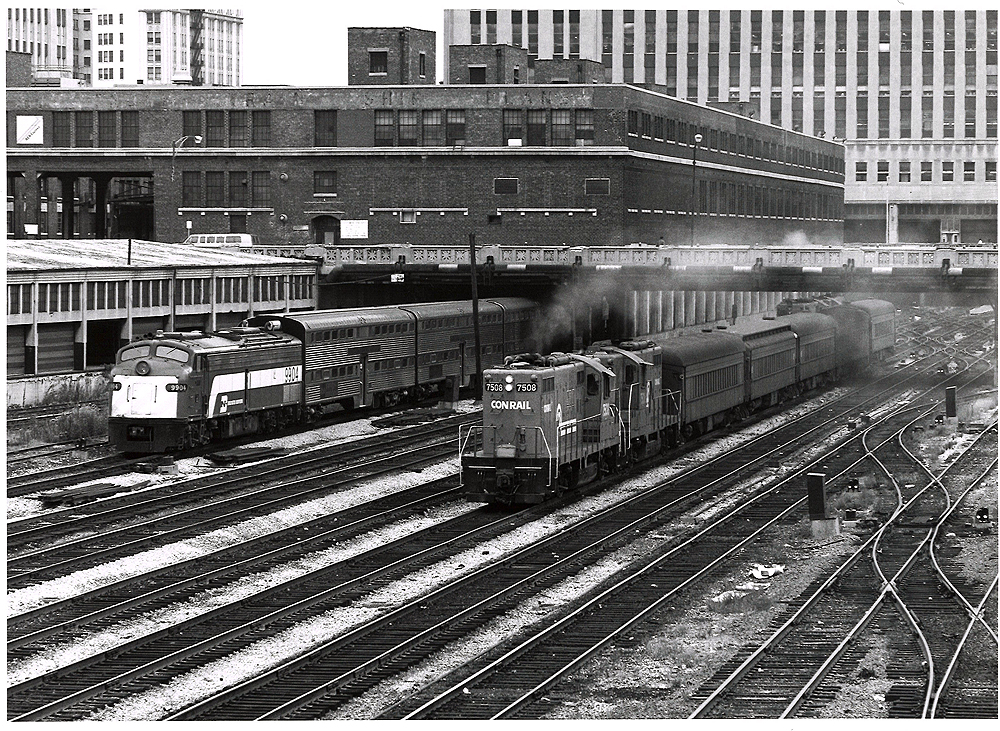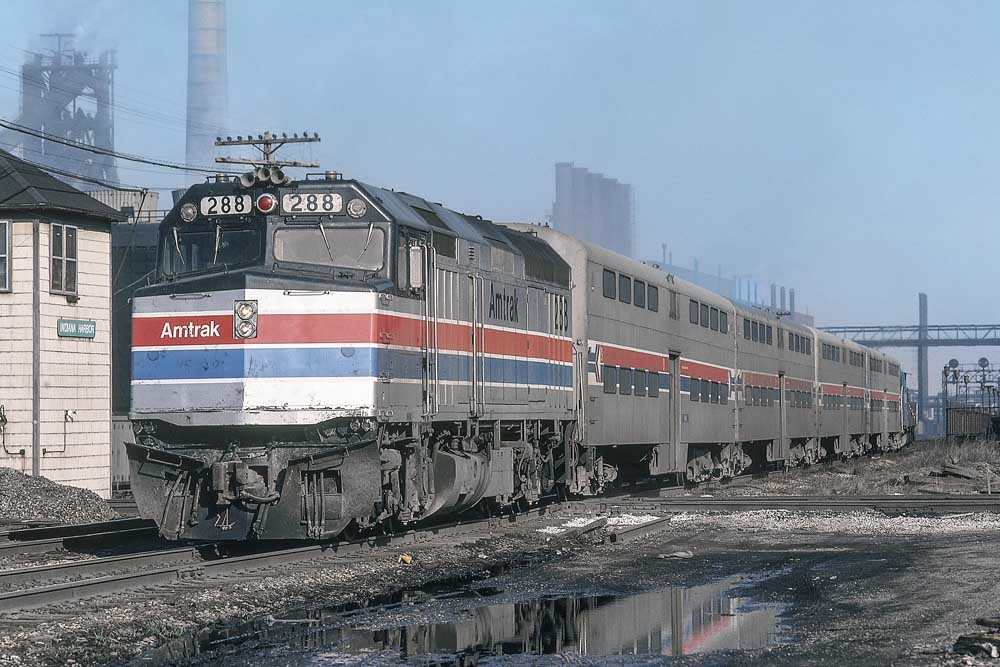Indiana’s Valpo Dummy commuter train could not garner the public support and funding needed to survive into the modern era.
In the 1890s, the Pennsylvania Railroad began operating commuter trains between Chicago and Valparaiso, Ind. Over the next century the service remained largely frozen in time, with operations changing relatively little as the trains passed from the PRR to Penn Central to Conrail and finally to Amtrak. Known to PRR operating personnel as “Dummies,” the fact the Valparaiso trains survived as long they did is remarkable given that none of the carriers that operated them wanted them and no public agency was willing to provide long-term funding to keep them going.
The Valparaiso commuter trains lived a “Perils of Pauline” existence replete with public funding fights, discontinuance threats, Congressional intervention, and complaints about shoddy service and equipment. They quietly made their final trips on May 3, 1991, after a plan to provide permanent funding failed in the Indiana legislature.
Service overview
For most of their history, the 44-mile Valparaiso commuter service consisted of two trains departing Valparaiso in early morning and leaving Chicago in late afternoon. The trains did not operate on weekends or holidays and used the same tracks as Pennsy’s fabled Blue Ribbon Fleet between Chicago and New York/Washington. The Valpo commuter trains were not considered intercity trains and thus ineligible to be picked up by Amtrak when the latter began operations on May 1, 1971.
Unlike most Chicago commuter lines, the Valparaiso commuter trains served a narrower market. Surveys conducted during the Conrail and Amtrak eras found that more than 90% of the ridership were Indiana residents commuting to work in downtown Chicago.
During the Penn Central era intermediate stops were made in Indiana at Whiting, Standard (Whiting), Mahoning, Indiana Harbor, Buffington, Gary (5th and Chase streets), Hobart, and Wheeler. In Illinois, the trains stopped at Englewood and State Line stations.
Into the Conrail era the Valparaiso equipment pool consisted of 14 heavyweight P70F coaches built 1926-29 and last overhauled in the late 1960s. A few more modern former Erie-Lackawanna coaches were assigned to the service after the discontinuance of EL’s Cleveland-Youngstown commuter service in early 1977.
Some cars had broken or rusted-out water storage tanks, which meant lavatories lacked running water. Heating and air conditioning systems frequently malfunctioned. During a blizzard in January 1979, none of the cars had heat or lights. Amtrak maintained the equipment under contract in Chicago and said the cars were virtually impossible to repair.
During the final years of Pennsy operation, ridership of the Valpo trains rose from 237,000 annually in 1965 to 250,858 in 1967. The upward trend continued into the Penn Central era, cresting in 1973 at 425,435 annually. Patronage was still relatively robust in 1976 when Conrail took over the trains in 1976, with annual ridership at 332,582.

Living on grants and court orders
Even as ridership was peaking in the mid-1970s, Penn Central was demanding public funding of the Valparaiso service, saying the trains lost $843,000 in 1974. A 1975 report by the United States Railway Association recommended ending the trains unless they received public funding. The Chicago-based Regional Transportation Authority declined to provide funding because by then the “Dummies” had no intermediate stops in Illinois. No Indiana agency was interested in providing funding, either. Penn Central never received any public money for the service.
After Conrail took over the service on April 1, 1976, it received a $500,000 federal mass transit grant. When that money ran out, Conrail posted the trains for discontinuance effective April 8, 1977. A court order obtained by the Indiana Public Service Commission and the United Transportation Union kept the trains rolling for another month.
In the meantime, IPSC agreed to fund the service through September. When that funding ended and Conrail threatened to end the trains, the Northwest Indiana Regional Transportation Authority provided a $30,000 grant from various state and federal sources, keeping the Valpo trains rolling through Sept. 30, 1978.
On Aug. 1, 1978, Conrail posted 60-day discontinuance notices, which prompted the state of Illinois and city of Chicago to go to court to save the trains. Twice federal courts ordered the trains to continue, with one order issued five minutes before the first of the two trains was to depart Chicago Union Station for the final time. By then patronage had slid to 53% of its 1973 high-water mark. Driving down ridership was poor on-time performance, recurrent mechanical malfunctions (often no heat or air conditioning), fare increases, and habitual discontinuance threats.
In January 1979, Conrail assigned to the trains former Chicago & North Western bilevel intercity coaches leased from Amtrak. In July 1979, former Norfolk & Western coaches displaced from the Chicago-Orland Park (Ill.) commuter route were used in Valparaiso service.
The U.S. Court of Appeals for the Seventh Circuit ruled in early 1979 that Conrail needed Interstate Commerce Commission approval to end the Valparaiso trains, which Conrail sought in February. The ICC decided to conduct an investigation of the discontinuance plan, which meant the trains would continue through September. In the meantime, Indiana Congressman Adam Benjamin Jr. sponsored an amendment to the Amtrak Improvement Act of 1979 directing Amtrak to take over.

Fading under the Amtrak banner
Amtrak took over the Valparaiso trains on Oct. 29, 1979. Effective Aug. 3, 1980, Amtrak named them the Indiana Connection (Nos. 321/324) and Calumet (Nos. 322/323). The names lacked a railroad heritage but described the region of Northwest Indiana they served. The running time was 1:10 minutes for one pair and 1:15 for another.
Under Amtrak auspices, the trains departed Valparaiso at 6 a.m. and 6:30 a.m. and Chicago Union Station at 5:05 p.m. and 5:35 p.m. Intermediate stations were Whiting, Indiana Harbor, two stations in Gary, Hobart, and Wheeler. Service to the new Hammond-Whiting Amtrak station began in September 1982.
Equipment assignments included the ex-C&NW bilevel coaches with locomotives on each end due to the lack of turning facilities in Valparaiso. Motive power varied and included the last two E units based in Chicago (Nos. 413 and 434). The last SDP40F locomotives based in Chicago pulled the trains in 1981. Also assigned were F40PH units and P30CH units. In the latter years under Amtrak, the equipment was typically an F40, two Horizon Fleet coaches, and a former Metroliner cab car. Ridership rose after Amtrak took over, cresting at 250,248 annually in fiscal year 1982 (Oct. 1, 1982-Sept. 30, 1983).
As Penn Central and Conrail had done, Amtrak demanded public funding for the trains. Amtrak President W. Graham Claytor Jr. said in 1985 that the Valpo trains were the passenger carrier’s least efficient trains in cost per passenger mile.
Faced with a budget shortfall, Amtrak ran the Indiana Connection for the final time on January 10, 1986. That discontinuance dealt ridership a blow from which it never recovered. Whereas the Calumet and Indiana Connection had collectively averaged 1,785 a day in 1985, the end of one roundtrip sent ridership down to an average of 534 a day. By 1990, monthly ridership of the Calumet averaged 11,662 passengers per month. By contrast, the nearby South Shore Line averaged 11,895 riders per day. Amtrak fares were generally higher than South Shore fares for the same distance traveled.
By the late 1980s, Conrail had shifted most of its freight trains off the route used by the Calumet as well as Amtrak’s Broadway Limited and Capitol Limited. Conrail notified Amtrak in March 1988 that it was responsible for the maintenance cost of the route east of CP 501 in Gary.
Amtrak eventually reached agreements with Conrail and CSX to shift the Capitol Limited and Broadway respectively to other routes. But the Calumet could not as easily be rerouted. The deteriorating track conditions led to the running time being lengthened to 1:20. Signal malfunctions and other operating issues frequently delayed the Calumet. Moreover, the Calumet was projected to lose 15.8 cents per passenger mile in FY1989. Federal law at the time prohibited Amtrak from operating short-haul trains that lost more than 16.3 cents per passenger miles.
Public officials in Northwest Indiana discussed putting the Calumet under the auspices of the Northern Indiana Commuter Transportation District, the agency overseeing South Shore Line commuter trains. But that would have required approval of the Indiana General Assembly.
The Calumet was the nation’s only commuter train without a local funding source. NITCD agreed to study assuming control of the Calumet. Its report was expected to be presented to the Indiana legislature with a funding proposal. Amtrak agreed to continue running the Calumet while NITCD conducted its study, which also would examine moving the Valparaiso trains to another route. Supporters of keeping the Calumet appealed to the Indiana Department of Transportation for funding.
The inevitable end
Amtrak wanted to be rid of the Calumet by late 1990, saying it was losing 17.5 cents per passenger mile and was expected to lose at least $1 million in FY1991. Ridership had slid to an average of 216 per trip. Northwest Indiana interests proposed imposing a 1-cent sales tax in Lake, Porter, and LaPorte counties to fund mass transit projects, including the Calumet. However, the state legislature wouldn’t be back in session until January 1991. Indiana Congressman Peter Visclosky and Indiana Senator Dan Coats bought time by gaining Congressional approval of a proviso directing Amtrak to operate the Calumet through May 6, 1991.
The NICTD report released in February 1991 was not promising. It projected the annual cost of operating the Calumet at $1.96 million. Buying 19 miles of track used by the train that Conrail didn’t want would cost $3.38 million. Using other routes would involve costly capital costs. And who would pay for it?














Where did the “Dummy” term come from? Seems it could have been profitable when it had better maintenance. I’m sure the effects of the rising automobile owner/ridership contributed to its demise.
“If you don’t build (maintain) it, people won’t come”? 😜